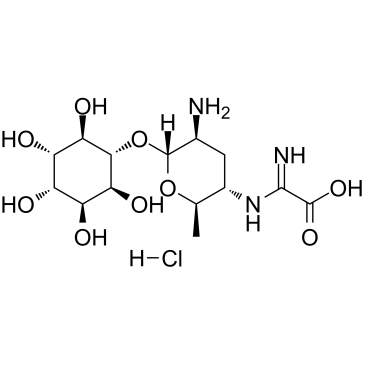CHEMICAL IDENTIFICATION
-
RTECS NUMBER :
-
NM7521800
-
CHEMICAL NAME :
-
D-chiro-Inositol, 3-O-(2-amino-4-((carboxyiminomethyl)amino)-2,3,4,6-te tradeoxy-alpha-D- arabino-hexopyranosyl)-, monohydrochloride
-
CAS REGISTRY NUMBER :
-
19408-46-9
-
LAST UPDATED :
-
199410
-
DATA ITEMS CITED :
-
10
-
MOLECULAR FORMULA :
-
C14-H25-N3-O9.Cl-H
-
MOLECULAR WEIGHT :
-
415.88
HEALTH HAZARD DATA
ACUTE TOXICITY DATA
-
TYPE OF TEST :
-
LD50 - Lethal dose, 50 percent kill
-
ROUTE OF EXPOSURE :
-
Oral
-
SPECIES OBSERVED :
-
Rodent - rat
-
DOSE/DURATION :
-
22 gm/kg
-
TOXIC EFFECTS :
-
Details of toxic effects not reported other than lethal dose value
-
REFERENCE :
-
JPIFAN Japan Pesticide Information. (Japan Plant Protection Assoc., 1-43-11, Komagome, Toshima-ku, Tokyo 170, Japan) No.1-61, 1969-92. For publisher information, see AGJAEP. Volume(issue)/page/year: (10),66,1972
-
TYPE OF TEST :
-
LD50 - Lethal dose, 50 percent kill
-
ROUTE OF EXPOSURE :
-
Intraperitoneal
-
SPECIES OBSERVED :
-
Rodent - rat
-
DOSE/DURATION :
-
12 gm/kg
-
TOXIC EFFECTS :
-
Details of toxic effects not reported other than lethal dose value
-
REFERENCE :
-
JPIFAN Japan Pesticide Information. (Japan Plant Protection Assoc., 1-43-11, Komagome, Toshima-ku, Tokyo 170, Japan) No.1-61, 1969-92. For publisher information, see AGJAEP. Volume(issue)/page/year: (10),66,1972
-
TYPE OF TEST :
-
LD50 - Lethal dose, 50 percent kill
-
ROUTE OF EXPOSURE :
-
Subcutaneous
-
SPECIES OBSERVED :
-
Rodent - rat
-
DOSE/DURATION :
-
17 gm/kg
-
TOXIC EFFECTS :
-
Details of toxic effects not reported other than lethal dose value
-
REFERENCE :
-
JPIFAN Japan Pesticide Information. (Japan Plant Protection Assoc., 1-43-11, Komagome, Toshima-ku, Tokyo 170, Japan) No.1-61, 1969-92. For publisher information, see AGJAEP. Volume(issue)/page/year: (10),66,1972
-
TYPE OF TEST :
-
LD50 - Lethal dose, 50 percent kill
-
ROUTE OF EXPOSURE :
-
Intravenous
-
SPECIES OBSERVED :
-
Rodent - rat
-
DOSE/DURATION :
-
5200 mg/kg
-
TOXIC EFFECTS :
-
Details of toxic effects not reported other than lethal dose value
-
REFERENCE :
-
JPIFAN Japan Pesticide Information. (Japan Plant Protection Assoc., 1-43-11, Komagome, Toshima-ku, Tokyo 170, Japan) No.1-61, 1969-92. For publisher information, see AGJAEP. Volume(issue)/page/year: (10),66,1972
-
TYPE OF TEST :
-
LD50 - Lethal dose, 50 percent kill
-
ROUTE OF EXPOSURE :
-
Oral
-
SPECIES OBSERVED :
-
Rodent - mouse
-
DOSE/DURATION :
-
20500 mg/kg
-
TOXIC EFFECTS :
-
Behavioral - food intake (animal) Behavioral - changes in motor activity (specific assay) Lungs, Thorax, or Respiration - dyspnea
-
REFERENCE :
-
JJANAX Japanese Journal of Antibiotics. (Japan Antibiotics Research Assoc., 2-20-8 Kamiosaki, Shinagawa-ku, Tokyo 141, Japan) V.21- 1968- Volume(issue)/page/year: 21,206,1968
-
TYPE OF TEST :
-
LD50 - Lethal dose, 50 percent kill
-
ROUTE OF EXPOSURE :
-
Intraperitoneal
-
SPECIES OBSERVED :
-
Rodent - mouse
-
DOSE/DURATION :
-
7600 mg/kg
-
TOXIC EFFECTS :
-
Details of toxic effects not reported other than lethal dose value
-
REFERENCE :
-
AACHAX Antimicrobial Agents and Chemotherapy (1961-70). (Ann Arbor, MI) 1961-70. For publisher information, see AMACCQ. Volume(issue)/page/year: -,225,1969
-
TYPE OF TEST :
-
LD50 - Lethal dose, 50 percent kill
-
ROUTE OF EXPOSURE :
-
Subcutaneous
-
SPECIES OBSERVED :
-
Rodent - mouse
-
DOSE/DURATION :
-
12 gm/kg
-
TOXIC EFFECTS :
-
Vascular - shock Lungs, Thorax, or Respiration - dyspnea Lungs, Thorax, or Respiration - other changes
-
REFERENCE :
-
JJANAX Japanese Journal of Antibiotics. (Japan Antibiotics Research Assoc., 2-20-8 Kamiosaki, Shinagawa-ku, Tokyo 141, Japan) V.21- 1968- Volume(issue)/page/year: 21,206,1968
-
TYPE OF TEST :
-
LD50 - Lethal dose, 50 percent kill
-
ROUTE OF EXPOSURE :
-
Intravenous
-
SPECIES OBSERVED :
-
Rodent - mouse
-
DOSE/DURATION :
-
3850 mg/kg
-
TOXIC EFFECTS :
-
Details of toxic effects not reported other than lethal dose value
-
REFERENCE :
-
AACHAX Antimicrobial Agents and Chemotherapy (1961-70). (Ann Arbor, MI) 1961-70. For publisher information, see AMACCQ. Volume(issue)/page/year: -,225,1969
-
TYPE OF TEST :
-
LD50 - Lethal dose, 50 percent kill
-
ROUTE OF EXPOSURE :
-
Unreported
-
SPECIES OBSERVED :
-
Rodent - mouse
-
DOSE/DURATION :
-
20900 mg/kg
-
TOXIC EFFECTS :
-
Details of toxic effects not reported other than lethal dose value
-
REFERENCE :
-
JPIFAN Japan Pesticide Information. (Japan Plant Protection Assoc., 1-43-11, Komagome, Toshima-ku, Tokyo 170, Japan) No.1-61, 1969-92. For publisher information, see AGJAEP. Volume(issue)/page/year: (2),18,1970
-
TYPE OF TEST :
-
LD - Lethal dose
-
ROUTE OF EXPOSURE :
-
Intravenous
-
SPECIES OBSERVED :
-
Primate - monkey
-
DOSE/DURATION :
-
>800 mg/kg
-
TOXIC EFFECTS :
-
Details of toxic effects not reported other than lethal dose value
-
REFERENCE :
-
JPIFAN Japan Pesticide Information. (Japan Plant Protection Assoc., 1-43-11, Komagome, Toshima-ku, Tokyo 170, Japan) No.1-61, 1969-92. For publisher information, see AGJAEP. Volume(issue)/page/year: (10),66,1972
|


